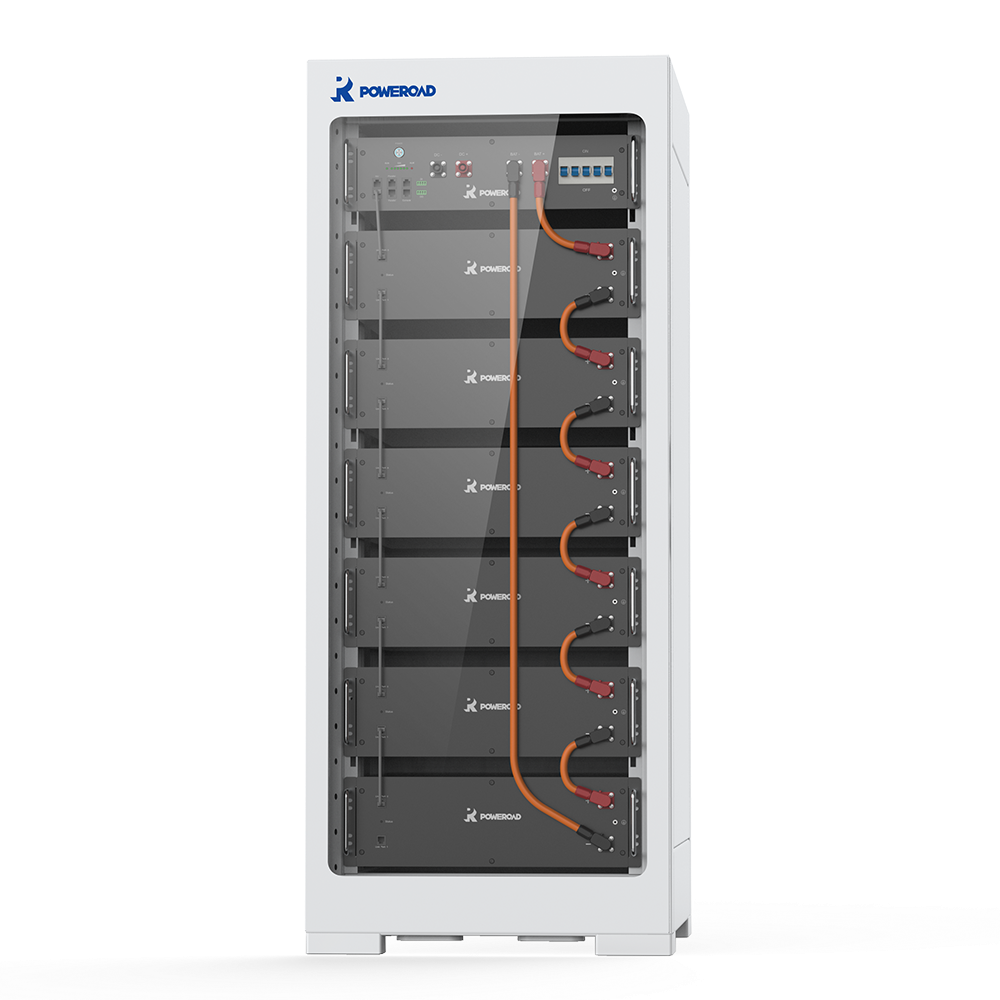

Engineered from the very beginning, POWEROAD Backer 4800 is one of the most reliable LiFePO4 rechargeable battery that can be used for home energy storage battery. For wholesale only.
Unlock a new level of energy control and sustainability with our 4.8 kWh battery. This high-capacity, rechargeable energy storage solution is designed to revolutionize how you manage and utilize electricity in your home or business.
We are dedicated to making the best and safest Lithium batteries by using safest LiFePO4 battery cells and most reliable components. As one member of the Backer series, the Backer 4800 is backed by the same highest quality as the Backer 2400 with premium performances and perfect compatibility for emergency backup power.
The Backer 4800 features with many advantages, like long service life, compact size, less weight, high rate charge and discharge and others. The battery can be connected with most inverters and chargers available in the market. Also, it can be used to develop a reliable solar battery bank together with most solar panels.
With more than 10 years’ experience in Lithium battery industry, POWEROAD knows well about specific battery requirements of each application, for example, battery for Uninterrupted Power Supply, for household usage, etc.
● High performance: Top-brand LiFePO4 Lithium battery ensuring safety and reliability
● 19 inch standard size for easy installation and maintenance operation
● Convenient charging: can be charged by original Lead acid battery charging system
● Thousands of cycles for long service life
● Parallel connection of 8 batteries for expanded battery capacity
● High rate discharge and charge
● Built-in BMS protects battery from abnormal conditions and ensures efficient operation
● Eco friendly: no lead. no heavy metals, no toxic element
|
Nominal Voltage |
48 V |
|
Capacity |
4.8 kWh |
|
Charging Voltage |
54V |
|
Charging Current Limit |
10 A |
|
Discharging Cut-off Voltage |
40.5 V |
|
Max. Continuous Charging Current |
100 A |
|
Max. Continuous Discharging Current |
100 A |
|
Weight |
50 kg |
|
Dimension (W x H x D) |
486×205×520 mm |
|
Operating Temperature |
0~45℃ (Charging) -20~60℃ (Discharging) |
|
Relative Humidity |
25%~85% RH |
|
Altitude |
≤4000 M |
|
Communication Interface |
RS485, CAN |
|
Remark |
If need more capacity, module can be connected in parallel max. 8P |
Q1. Can I use Backer 4800, the 48V power bank, for indoor distribution system?
A: Yes. The Backer 4800 is manufactured to be used for many applications, including backup power and home energy system. To build a complete home energy system, you can consult with the local distributor.
Q2. Can the Backer 4800 be connected in parallel and series?
A: The Backer 4800 can be assembled in parallel to get expanded capacity, but it cannot be wired in series.
In a world where energy sustainability and reliability are paramount, the role of advanced energy storage solutions cannot be overstated. Among the latest innovations in this field, the 4.8 kWh battery stands out as a powerhouse of possibilities. With its impressive capacity and versatile applications, it’s poised to revolutionize how we harness and manage electricity. In this article, we delve deep into the world of 4.8 kWh batteries, exploring their capabilities, applications, and the impact they can have on our energy landscape.
At the heart of the 4.8 kWh battery lies cutting-edge lithium-ion technology. This advanced chemistry allows for efficient energy storage and discharge, ensuring maximum performance and longevity. The capacity of 4.8 kWh, which stands for 4.8 kilowatt-hours, represents the amount of energy the battery can store and subsequently provide when needed. To put this into perspective, it’s enough to power a typical home for several hours or even days, depending on usage patterns.
Battery Cells: These are the fundamental building blocks, where energy is stored and released. High-quality lithium-ion cells are known for their reliability and energy density.
Battery Management System (BMS): The BMS is the brain of the battery. It monitors the state of charge, temperature, and voltage, ensuring safe and efficient operation.
Inverter: An inverter is often integrated into the battery system, allowing the stored DC (direct current) electricity to be converted into AC (alternating current) for household use.
Cooling System: Some 4.8 kWh battery come equipped with a cooling system to regulate temperature and prevent overheating, enhancing battery lifespan.
The versatility of a 4.8 kWh battery is a defining feature. Let’s explore some of its primary applications:
In homes equipped with solar panels, a 4.8 kWh battery becomes a valuable asset. It stores excess solar energy generated during the day for use during the evening or cloudy days. This not only maximizes self-consumption of renewable energy but also provides a reliable backup power source during grid outages.
Load shifting is a smart energy management strategy. A 4.8 kWh battery allows homeowners to store electricity during off-peak hours when energy rates are lower and use it during peak hours when rates are higher. This can lead to significant cost savings over time.
Reliability during power outages is a top priority. With a 4.8 kWh battery, critical appliances and devices can continue running seamlessly during blackouts, ensuring safety and comfort.
These batteries can also play a vital role in supporting the grid. In regions with high renewable energy penetration, they can stabilize the grid by absorbing excess energy when supply exceeds demand and releasing it when needed.
Beyond residential applications, 4.8 kWh battery find utility in commercial and industrial settings. They can enhance energy efficiency, reduce demand charges, and provide backup power for critical operations.
Energy Independence: 4.8 kWh battery empower homeowners and businesses to reduce their dependence on the grid and rely more on clean, renewable energy sources.
Cost Savings: Through load shifting and energy efficiency improvements, these batteries can lead to substantial long-term cost savings on electricity bills.
Environmental Impact: By promoting the use of clean energy, 4.8 kWh batteries contribute to reducing greenhouse gas emissions and combatting climate change.
Reliability: The backup power capabilities of these batteries offer peace of mind during outages, ensuring continued operation of essential equipment.
Upfront Costs: While the long-term savings are significant, the initial investment in a 4.8 kWh battery system can be substantial. However, many governments and utilities offer incentives and rebates to offset costs.
Installation Requirements: Proper installation by trained professionals is crucial to ensure safety and optimal performance. It’s essential to consider installation costs when planning to integrate a battery system.
The journey of 4.8 kWh batteries is far from over. Continuous innovation in battery technology promises to make these energy storage solutions even more efficient and accessible. Some emerging trends and innovations include:
Higher Energy Density: Future iterations of 4.8 kWh battery may offer higher energy density, allowing for greater energy storage in smaller, more compact units.
Longer Lifespan: Research into advanced battery chemistries aims to extend the lifespan of batteries, reducing the frequency of replacements and the associated costs.
Rapid Charging: Faster charging capabilities will make 4.8 kWh battery even more convenient and responsive to energy demands.
Recycling and Sustainability: Battery manufacturers are increasingly focused on recycling and sustainable disposal of batteries, mitigating environmental impacts.
Grid Integration: Enhanced grid integration features will enable these batteries to play a more active role in balancing and stabilizing the grid.
While the future is promising, there are challenges that need to be addressed as well:
Environmental Concerns: The production and disposal of lithium-ion batteries have raised environmental concerns. Sustainable practices and recycling solutions will be crucial.
Resource Availability: The availability of critical materials like lithium and cobalt may become a limiting factor in scaling up battery production. Researchers are exploring alternative materials and chemistries.
Safety: Ensuring the safety of battery systems is paramount. Efforts to prevent overheating, fires, and other safety risks must remain a priority.
Regulatory Frameworks: The development of clear and supportive regulatory frameworks for energy storage will be essential to facilitate widespread adoption.
As we look to the future, the role of 4.8 kWh battery in our energy landscape is poised to expand. With advancements in technology, we can expect even more efficient and affordable solutions. The integration of artificial intelligence and smart grid technologies will further enhance the capabilities of these batteries, enabling them to adapt to changing energy demands in real-time.
In conclusion, the 4.8 kWh battery represents a significant leap forward in energy storage and management. Its versatility, reliability, and sustainability make it a valuable addition to both residential and commercial energy systems. As we continue to prioritize clean energy and resilience in our power infrastructure, these batteries will play an increasingly vital role in shaping the future of energy. Embrace the power of the 4.8 kWh battery, and join the movement toward a more sustainable and reliable energy future.

Visit us
Email Us
Navigation
QR Code
